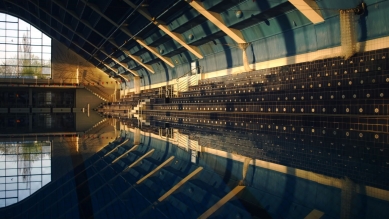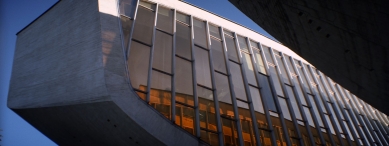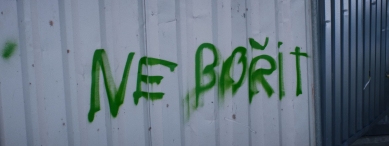
Film Architektura ČSSR 58–89 Jana Zajíčka a Vladimira 518 vstupuje do kin
The feature documentary film "Architecture of Czechoslovakia 58–89" by director Jan Zajíček and concept author, musician, and multimedia artist Vladimir 518 will officially enter theaters on November 7. The film offers an extraordinary perspective on Czech and Slovak architecture from the years 1958–1989, which was created during the communist regime but managed to engage the expertise of the public in the Western world. The creators focus not only on exceptional and timeless buildings constructed during the period from the World Expo EXPO 58 in the territory of what was then Czechoslovakia but also on the fascinating and extraordinary creative energy that accompanied their inception. After its world premiere at the Karlovy Vary International Film Festival, the film was screened with great interest at the Finále Plzeň and Film and Architecture festivals, as well as in a series of screenings associated with discussions featuring the creators, which attracted sold-out audiences. In the upcoming weeks, selected screenings will be accompanied by discussions; for example, on November 15, audiences at the Světozor cinema will have the opportunity to meet with director Jan Zajíček and architect Václav Aulický, or on November 27 at CAMP with Vladimir 518. In Slovakia, the film will have its distribution premiere on November 21. The main producer of the film is the company FILM KOLEKTIV, and its distributor is Aerofilms. The film's trailer is available at https://youtu.be/plqopmpfLz4.
"Architecture of Czechoslovakia 58–89" is the first film that comprehensively maps Czechoslovak architecture from the second half of the 20th century. One of its objectives is to remove the burden of prejudice against the so-called communist architecture and to unveil the strategies of architectural creation during a time when the state was the absolute commissioner, yet many bold, modern, and inspiring buildings were born in the country. “Of course, I perceive a strong aesthetic dimension to the whole of this era, but what attracted me the most was the story. I am particularly fascinated by the contexts, relationships, struggles, personal and societal dramas that stand behind the creation of these concepts and ultimately the finished buildings,” explains director Jan Zajíček. The film also resonates with the rivalry that existed between Czech architects and their Slovak colleagues during the previous regime.
The film conveys testimonies from personalities who, despite the complex conditions, were able to realize quality projects and keep pace with global architectural trends. “What primarily fascinates me about this period is the courage of the most progressive creators of the time to stand up to the pressure of socialist realism, their unyielding tendency toward international expression and world architecture. It also seems very difficult to comprehend today the technological context in which they had to operate. Every solution was actually an original response to the formal requirements, to the artistic expression that they wanted to achieve,” adds concept author Vladimir 518. Audiences will encounter personalities in the film such as Alena Šrámková, Václav Aulický, Miroslav Masák, Martin Rajniš, Otakar Binar, Zdenka M. Nováková, Zdeněk Rothbauer, Jiří Suchomel, Zbyšek Štybl, or Ivan Matušík, Iľja Skoček, Viera Mecková, Alexander Mlynárčik, Ján M. Bahna, as well as their younger colleagues Josef Pleskot and Ladislav Lábus. Their testimonies are complemented by sculptor and painter Stanislav Kolíbal and theorists Rostislav Švácha, Radomíra Sedláková, Henrieta Moravčíková, Matúš Dulla, Peter Szalay, and structural engineer Pavel Čížek. The creators will also recall personalities who were no longer with us at the time of filming, such as Karel Prager, Vladimír Dedeček, Štefan Svetko, or Vladimír Machonin. The film by Jan Zajíček and Vladimir 518 was developed over seven years. The first and now unique footage of the film was captured by the production team during the demolition of the Transgas building (architects Jiří Eisenreich, Ivo Loos, Jindřich Malátek, Václav Aulický), an iconic structure of Czech brutalism that stood on Prague's Vinohradská street until 2020.
The film with extraordinary visual and editing originality also captures the stories of other remarkable buildings in the Czech Republic and Slovakia. In Prague, filming took place, for example, at the Institute of Macromolecular Chemistry in Břevnov (architect Karel Prager), at the New Stage of the National Theatre (Karel Prager), in the former InterContinental Hotel (Karel Filsak, Karel Bubeníček, Jaroslav Švec), in the premises of the Podolí Swimming Stadium (Richard Podzemný), in the building of the former Federal Assembly (Karel Prager, Jiří Kadeřábek, Jiří Albrecht), at the Žižkov Television Tower (Václav Aulický), or in department stores Kotva (Věra Machoninová, Vladimír Machonin) and Máj (Miroslav Masák, John Eisler, Martin Rajniš). The film crew also captured the Karlovy Vary Thermal Hotel (Věra Machoninová, Vladimír Machonin), the prestigious Perret Award-winning television transmitter and hotel on Ještěd (Karel Hubáček), and the complex of buildings housing the Transit Telephone Exchange in Hradec Králové (Jindřich Malátek, Jiří Eisenreich, Václav Aulický, Jan Fišer). Extraordinary buildings in Bratislava represented in the film include the Slovak Radio building (Štefan Svetko, Štefan Ďurkovič, Barnabáš Kissling) constructed in the shape of an inverted pyramid, the seat of the Slovak National Gallery with a controversial extension from the 1970s (Vladimír Dedeček), the suspended Bridge of the Slovak National Uprising over the Danube River (Jozef Lacko, Arpád Tesár, Jozef Zvara, Ladislav Kušnír, Ivan Slameň), or the circular shopping center Slimák on Kukučín Street (Ivan Matušík). In Slovakia, filmmakers also shot in the spaces of the modernist complex of the Agricultural University in Nitra (Vladimír Dedeček, Rudolf Miňovský) or in Ružomberok, where they were fascinated by the bold structure of the Ľudovít Fully Gallery (Martin Kusý). Jan Zajíček and Vladimir 518 did not meet for the first time while working on the film Architecture of Czechoslovakia 58–89. Jan Zajíček had already directed music videos for Vladimir's band PSH (Peneři Strýčka Homeboye) in the 1990s; they also collaborated on the series/project Kmeny. Jan Zajíček has also directed the documentary film Girl Power about women in graffiti and a number of award-winning music videos for other bands, such as Sunshine or Pio Squad. As a visual artist and animator, he collaborated with the National Theatre and the dance ensemble VerTeDance. Vladimir 518 straddles various artistic disciplines. He is a notable musician, but also the founder of the Bigg Boss publishing house, which published, among other things, a series of books on Czech subcultures called Kmeny and is active in the visual arts scene.
Architecture of Czechoslovakia 58–89 is the culmination of a multi-year project, which included the extensive publication "Architecture 58–89" by Vladimir 518, published two years ago by the Bigg Boss publishing house and accompanied by an exhibition at the CAMP – Center for Architecture and Urban Planning in Prague. Following the publication, a series was produced and aired on Czech Television last year.
The documentary film was created in co-production with FILM KOLEKTIV (producers Karla Stojáková and Pavel Berčík), AZYL Production (producers Maroš Hečko and Peter Veverka), Czech Television (creative producer Martina Šantavá), and RTVS (creative producer Roman Genský). The production was supported by the State Fund for Cinematography, the Audiovisual Fund Slovakia, the Ministry of Culture SK, and the Prague Audiovisual Endowment Fund. Screenings and discussions with creators across the Czech Republic were supported by the Czech Chamber of Architects. The Prague premiere took place with the support of Family Office R2G – the family of Oldřich Šlemr, Eduard Kučera, and Pavel Baudiš.
"Architecture of Czechoslovakia 58–89" is the first film that comprehensively maps Czechoslovak architecture from the second half of the 20th century. One of its objectives is to remove the burden of prejudice against the so-called communist architecture and to unveil the strategies of architectural creation during a time when the state was the absolute commissioner, yet many bold, modern, and inspiring buildings were born in the country. “Of course, I perceive a strong aesthetic dimension to the whole of this era, but what attracted me the most was the story. I am particularly fascinated by the contexts, relationships, struggles, personal and societal dramas that stand behind the creation of these concepts and ultimately the finished buildings,” explains director Jan Zajíček. The film also resonates with the rivalry that existed between Czech architects and their Slovak colleagues during the previous regime.
The film conveys testimonies from personalities who, despite the complex conditions, were able to realize quality projects and keep pace with global architectural trends. “What primarily fascinates me about this period is the courage of the most progressive creators of the time to stand up to the pressure of socialist realism, their unyielding tendency toward international expression and world architecture. It also seems very difficult to comprehend today the technological context in which they had to operate. Every solution was actually an original response to the formal requirements, to the artistic expression that they wanted to achieve,” adds concept author Vladimir 518. Audiences will encounter personalities in the film such as Alena Šrámková, Václav Aulický, Miroslav Masák, Martin Rajniš, Otakar Binar, Zdenka M. Nováková, Zdeněk Rothbauer, Jiří Suchomel, Zbyšek Štybl, or Ivan Matušík, Iľja Skoček, Viera Mecková, Alexander Mlynárčik, Ján M. Bahna, as well as their younger colleagues Josef Pleskot and Ladislav Lábus. Their testimonies are complemented by sculptor and painter Stanislav Kolíbal and theorists Rostislav Švácha, Radomíra Sedláková, Henrieta Moravčíková, Matúš Dulla, Peter Szalay, and structural engineer Pavel Čížek. The creators will also recall personalities who were no longer with us at the time of filming, such as Karel Prager, Vladimír Dedeček, Štefan Svetko, or Vladimír Machonin. The film by Jan Zajíček and Vladimir 518 was developed over seven years. The first and now unique footage of the film was captured by the production team during the demolition of the Transgas building (architects Jiří Eisenreich, Ivo Loos, Jindřich Malátek, Václav Aulický), an iconic structure of Czech brutalism that stood on Prague's Vinohradská street until 2020.
The film with extraordinary visual and editing originality also captures the stories of other remarkable buildings in the Czech Republic and Slovakia. In Prague, filming took place, for example, at the Institute of Macromolecular Chemistry in Břevnov (architect Karel Prager), at the New Stage of the National Theatre (Karel Prager), in the former InterContinental Hotel (Karel Filsak, Karel Bubeníček, Jaroslav Švec), in the premises of the Podolí Swimming Stadium (Richard Podzemný), in the building of the former Federal Assembly (Karel Prager, Jiří Kadeřábek, Jiří Albrecht), at the Žižkov Television Tower (Václav Aulický), or in department stores Kotva (Věra Machoninová, Vladimír Machonin) and Máj (Miroslav Masák, John Eisler, Martin Rajniš). The film crew also captured the Karlovy Vary Thermal Hotel (Věra Machoninová, Vladimír Machonin), the prestigious Perret Award-winning television transmitter and hotel on Ještěd (Karel Hubáček), and the complex of buildings housing the Transit Telephone Exchange in Hradec Králové (Jindřich Malátek, Jiří Eisenreich, Václav Aulický, Jan Fišer). Extraordinary buildings in Bratislava represented in the film include the Slovak Radio building (Štefan Svetko, Štefan Ďurkovič, Barnabáš Kissling) constructed in the shape of an inverted pyramid, the seat of the Slovak National Gallery with a controversial extension from the 1970s (Vladimír Dedeček), the suspended Bridge of the Slovak National Uprising over the Danube River (Jozef Lacko, Arpád Tesár, Jozef Zvara, Ladislav Kušnír, Ivan Slameň), or the circular shopping center Slimák on Kukučín Street (Ivan Matušík). In Slovakia, filmmakers also shot in the spaces of the modernist complex of the Agricultural University in Nitra (Vladimír Dedeček, Rudolf Miňovský) or in Ružomberok, where they were fascinated by the bold structure of the Ľudovít Fully Gallery (Martin Kusý). Jan Zajíček and Vladimir 518 did not meet for the first time while working on the film Architecture of Czechoslovakia 58–89. Jan Zajíček had already directed music videos for Vladimir's band PSH (Peneři Strýčka Homeboye) in the 1990s; they also collaborated on the series/project Kmeny. Jan Zajíček has also directed the documentary film Girl Power about women in graffiti and a number of award-winning music videos for other bands, such as Sunshine or Pio Squad. As a visual artist and animator, he collaborated with the National Theatre and the dance ensemble VerTeDance. Vladimir 518 straddles various artistic disciplines. He is a notable musician, but also the founder of the Bigg Boss publishing house, which published, among other things, a series of books on Czech subcultures called Kmeny and is active in the visual arts scene.
Architecture of Czechoslovakia 58–89 is the culmination of a multi-year project, which included the extensive publication "Architecture 58–89" by Vladimir 518, published two years ago by the Bigg Boss publishing house and accompanied by an exhibition at the CAMP – Center for Architecture and Urban Planning in Prague. Following the publication, a series was produced and aired on Czech Television last year.
The documentary film was created in co-production with FILM KOLEKTIV (producers Karla Stojáková and Pavel Berčík), AZYL Production (producers Maroš Hečko and Peter Veverka), Czech Television (creative producer Martina Šantavá), and RTVS (creative producer Roman Genský). The production was supported by the State Fund for Cinematography, the Audiovisual Fund Slovakia, the Ministry of Culture SK, and the Prague Audiovisual Endowment Fund. Screenings and discussions with creators across the Czech Republic were supported by the Czech Chamber of Architects. The Prague premiere took place with the support of Family Office R2G – the family of Oldřich Šlemr, Eduard Kučera, and Pavel Baudiš.
The English translation is powered by AI tool. Switch to Czech to view the original text source.



0 comments
add comment











